Did you know that you can live about 3 weeks without food? And water…you can spend about 7 days without it before your body completely shuts down. But what about breathing?
If you’ve ever challenged your friends to a breath-holding contest as a child, you probably already know that you can’t go more than a minute or two without oxygen. More than that, and you quickly lose consciousness, and shortly thereafter your body begins to sustain damage that is often irreversible. This is a very important point that we all forget; breathing is one of the most vital functions of our lives, yet we tend to take it for granted.
Neither Fish nor Fowl
Breathing is the only biological function within our bodies that straddles the line between conscious and subconscious control. In our day-to-day lives, breathing is what keeps us alive; an almost involuntary movement of the chest to expand the lungs and bring in oxygen that will go on to feed every cell in our bodies and help break down nutrients into energy.
In fact, breathing is so synonymous with our identity as human beings, that if you take a really deep breath, it is thought that it’s statistically probable for you to inhale at least one air molecule that was exhaled by Julius Caesar in his last, dying breath.
Unlike other vital processes, like the heartbeat for example, breathing can be taken over from the subconscious mind by our active intention. We can slow our breath, deepen it, observe the instantaneous moment when an inhalation becomes an exhalation, and even feel the accelerating heartbeat when we draw in the same oxygen/nitrogen mixture that our ancestors have relied on for hundreds of thousands of years, without even thinking about it.
It is this conscious collaboration and observation of our breathing that so captivated the ancient mystics who valued intentional, rhythmic breathing as a fundamental spiritual pursuit. Today, our breath remains a central tenet of many spiritual practices as well as a point of intense interest in scientific communities. Like digestion, breathing is a deceptively simple mechanism that has the potential to provide not just health to the body but strength and peace to the mind.
Physical Implications of Breathing
When a newborn baby takes her first breath, it is her first act as an independent human being. This first breath is an instinct that will repeat itself millions of times over the course of her life. It is a tool, always at the ready to protect her in all the challenges life will bring. Whether it’s helping her create the energy to run a marathon in high school, or to give her mind rhythm to meditate before a college exam, this baby forms an intricate bond with breathing the moment she enters the world. But let’s consider this bond, and how this might function, in more detail.
The list of common ailments experienced in the life of a typical American paints a sad story. Stress-related illness due to high blood pressure, heart disease, depression, and digestive maladies are just a few of the preventable conditions that plague our society. For example, the stress hormone cortisol is identified as one of the driving forces behind the “fight or flight” response. In nature, this hormone sensitizes animals to impending danger, heightening their senses for defense or a speedy getaway. Humans possess the same process.
The problem occurs when a relentless barrage of stresses (work, family, personal goals, health problems, traffic, noise, etc.) causes a steady activation of the fight or flight response in our bodies. When cortisol floods the body due to consistent stressful mindsets, it has a corrosive effect on body organs including the brain and heart. With no relief from these stresses, chemicals like cortisol begin to have very negative effects on our bodies.
However, the simple act of consciously deepening our breathing can work to pacify the mind and undo some of the damage wrought by stress hormones. For example, science has shown that through meditative exercises like breath-work, dopamine and serotonin levels in the blood are increased, fighting the negative effects of overactive cortisol production.
Physiologically speaking, shallow breathing is itself a typical symptom of anxiety, whereas long, slow breathing is the behavior of the body in a state of confidence and relaxation. In this way, the health of the body takes cues from the breath. By simply focusing on our breath and consciously slowing it down, we give our body’s genetically-ingrained responses a life line that can regulate stress and help us engage positive thought patterns, thereby directly improving the chemistry in our bodies.
The same works for energy levels and concentration. Sure, breathing is effective for increasing focus during mediation, but it can increase your energy levels too. For example, if you’re sitting down to binge-watch the latest new release on Netflix, or are listening to a professor in a lecture hall, you may notice that you’re feeling tired and sluggish.
This is not a coincidence, because your posture can directly affect how deep your breaths are, which in turn affects your oxygen intake. When oxygen levels begin to decrease due to shallow breaths, you can quickly start to feel tired and sleepy. Next time you find yourself in a situation like this, sit up, straighten your back, and begin to consciously take fuller and deeper breaths. Within a few seconds you will feel more energetic, because your blood has become more oxygenated, and more oxygen is now reaching your brain.
Breathing and Psychology
It is interesting to note how the discipline of mindful breathing affects not just the body but our emotional/mindful selves as well. Some studies have been done in relation to specific brain regions and the emotions we experience, but science has a long way to go in understanding the true link.
When a person has the presence of mind to take notice of all the complexities of their own breath, the entire mental state becomes much more ordered and peaceful. Breath, with the heartbeat, are the two most important activities that go on in the body. By cultivating our participation and awareness of this, the most central action in our system, other causes of discomfort fade into the background.
Counting breaths as we draw them in and then release them give our brains a structured environment that helps push back extraneous emotions that are merely the bi-product of our evolution. Humans weren’t always as logical and abstract-thinking as we are today. Instead, our ancestors had to rely on emotions to survive, because life was less predictable, and if you didn’t react quickly, you got eaten.
But our lives today are very different because we have much more predictability and require a much more complex way of thinking. Our hunter and gatherer ancestors certainly didn’t have to worry about company meetings, paying taxes, filling out insurance forms, and selecting investments for their 401k – aspects of our lives where emotions tend to do more harm than good. So when we experience stress and worry that are brought in by external forces, it is our genetic toolkit trying to show us that there’s a problem – but a problem that emotions simply cannot solve (just try yelling at your 401k, and see how far that gets you).
The good thing is that we have a tool to drown out the emotional bursts that are sometimes pointless and can be so detrimental to our psychological health. By mindfully focusing on our breath, we put ourselves in a position to consciously push anxiety out of the center of the mind. When the center of the mind belongs to the life-giving mystery of the breath, it is hard for worry to get a foothold and take your mind on a rollercoaster ride that ends very much like a real roller coaster: though you took a crazy ride, you ended up in the same place, but now your heart is racing and your body is shaking.
Breathing and the Brain
Because we can control our emotions through breathing, and because emotions play a part in the development of our brain, we can essentially control the health of our brain through breathing. The brain changes structurally throughout life, and neural pathways controlling emotions, motivation, and countless other facets of life are forged and reinforced through practice and repetition. We form many of these mental pathways passively, through the routine motions of day-to-day life. This means that how you experience life will play a role in the development of your neural pathways.
Meditative thought, at its most basic, is a mental involvement in the present moment, guided most palpably by the breath. It is an act of self-centering. Peaceful, disciplined thinking put into practice. These beneficial and balanced thought patterns become hardwired in the very circuitry of the brain.
By actively choosing thought patterns based on peace and tranquility, these can become physical habits of the brain circuitry. In this way, a simple breathing exercise can have profound physical ramifications that change your thinking and your behavior in the long term, because of the physical changes in the brain.
The First Breath of Knowledge
Many traditional spiritual disciplines center themselves around awareness and control of breathing. Yoga, Tai Chi, Transcendental Meditation, and Qi Gong are just a few. Those just beginning to focus their minds on breathing will find it to be a challenge. Don’t believe it? Try it right now…Sit up straight in your chair, count once when you inhale and once when you exhale.
Now, see if you can get to 100 without becoming distracted or losing count. You’ll find that it’s not as easy as it seems at first. To set aside outside thoughts and the verbal mind for quiet contemplation is no easy task at first, even if that task is just to count your breaths. With practice, you will find it easier to steady the mind and body through intentional breathing.
In this way, the breath acts as gatekeeper between conscious and subconscious, body and mind. The spiritual and emotional benefits that active breathing can yield in the mind always cross over to greater health and wellness in the body. In the same way, a physically weak or unhealthy body puts the mind in a position to feel anxious and unstable thoughts. The breath is at the center of this interplay, and acts as a tunnel between two aspects of our lives that, despite all of our scientific advancements, still remain largely a mystery.
The breath brings the understanding that human life itself is just an extension of the breath; that without it life comes to an end. It is our greatest need and constant companion from birth to death.





Leave a Reply